(10)
Abbey House
& Horton H0use,
Church Street, Bradford on Avon
Church Street, Bradford on Avon
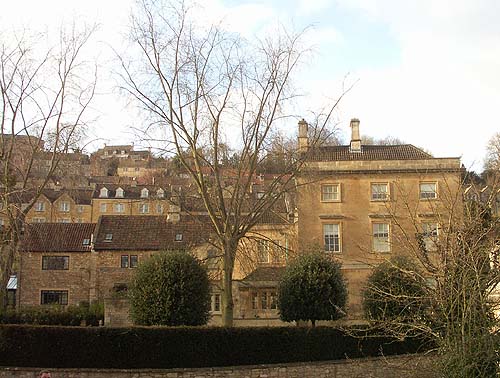
Horton
House and Abbey House
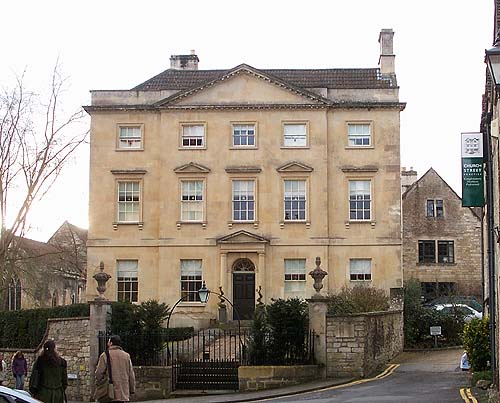
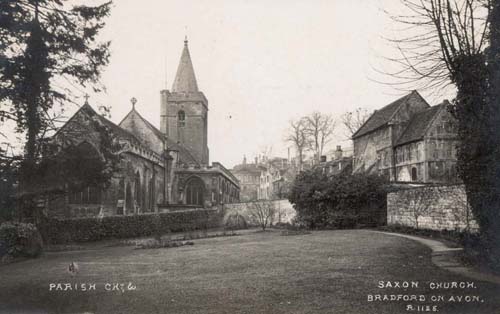
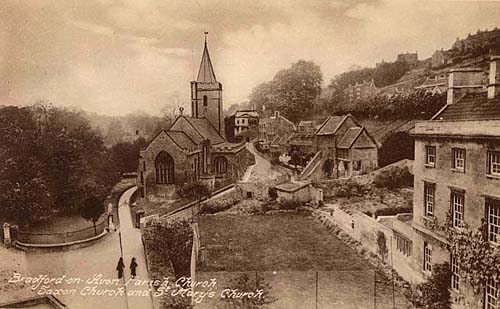
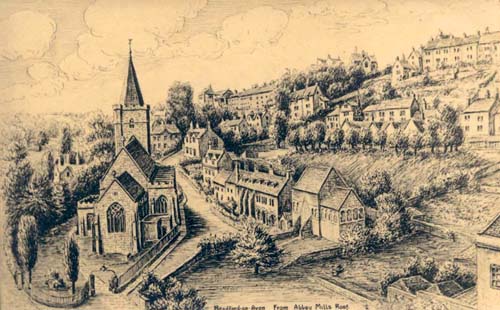
Part of the garden of Horton H0use bordering the
Anglo Saxon Church c.1920
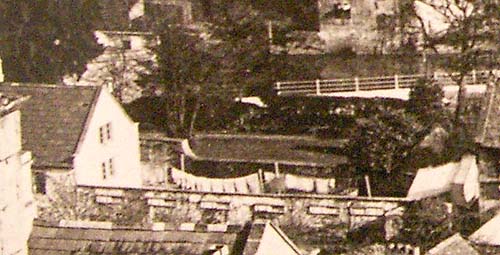
Horton
H0use c.1880 from the Tory

Horton
H0use c.1900 from the Tory
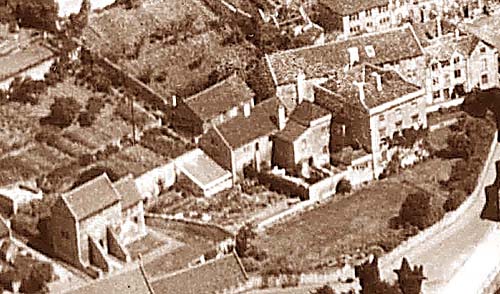
Aerial View of Horton H0use in 1930

Humphrey
Tugwell painted by Thomas Gainsborough
15 Church Street, Bradford on Avon
A GUIDE FOR VISITORS
This guide must be viewed as a first effort. Most of the information is based on professional research: credit here must be given to Richard Ashley. Barbara and Robert Harvey, Cedric and Christine Lisney. Pamela Slocombe, Martin Valatin and Roger Mawby. We aim to gradually remove any errors and to fill in any gaps involving not only the buildings but also the gardens: help here from Preservation Trust and Museum Society members will be much appreciated. Finally, we hope that our efforts will encourage other owners of historic houses not only to prepare for publication brief historical surveys of their own individual properties but also to open their doors to members.
Annette and John Seekings:
Introduction
Horton's House is approached across what was once known as Abbey Yard with Abbey House on the left and the Abbey Coach House on the right. From mid-19th to mid-20th century, most of this Abbey Yard was occupied by a large malthouse. Horton's House was built c1496 by the young Thomas Horton. His father John had already built up a successful business as a fuller, with several fulling mills on the Avon and Frome rivers, including Bradford. Before retiring comfortably c1518 to his final home at nearby Westwood Manor, Thomas transformed this business into a major manufactory of unfinished broadcloth, based on the vacant waterfront Abbey Yard site he had acquired in Bradford from Shaftesbury Abbey. It is possible that Thomas incorporated an earlier (14c?) manorial court house and bakery into his Bradford house; the splendid fireplace and the narrow sealed door-way in the north-east comer of the dining room appear to be earlier than the four main rooms of Horton's home. Further possible evidence of this incorporation of the court house is the difference in floor levels between the eastern and western "halves" of Horton's 1496 house. The property also then included the "Old Chapel" which was recognised several centuries later as a Saxon church.
Over the next five centuries three major alterations took place. To assist in explaining these alterations it should be understood that the main building is aligned approximately east-west, with die rear garden running uphill to the north and the lower garden running south towards the river.
The first of these three major alterations - probably carried out soon after the main house was built (early 16c? - doubled the size of the building by adding a matching extension to the west which reached almost to the walls of the Saxon Church; this extension appears to have been always used, until its demolition in the late 19th century, as a cloth work-shop. Most of the west and north walls of this extension remain today - the wide doorways and window surrounds of the workshop are still evident - despite having been reduced late 19th century into a vinery. Tins vinery existed until the mid 1960s when it made way for a modem extension occupying the east end of the vinery site. This modem extension incorporated much of the walls and stonework of the original work-shop, this being often evident from the blue lime-wash of the vinery walls into which the workshop had been converted. Other details of the vinery (Muscat vines and a water tank) have been recently revealed at the feel of the remaining workshop walls.
The second major alteration involved the rebuilding of the entire east wall immediately within the line of the original east wall, thus reducing the length of the original building by two to three feet. It is possible that this alteration took place to allow improved access to the Coach House either when it was built in the 1770s or when it was converted into a garage in the early 20th century. The thickness of this wall suggests the former.
The third of the major alterations was the addition of a new building linking Horton's House to the rear of Abbey House. Maps indicate that this probably took place in the late 19th century. It probably utilised material from the earlier workshop extension at die rear of Horton's House which was much reduced in size at about this time to form the vinery.
Historic Background
Before exploring Horton's House, the visitor will perhaps appreciate a brief summary of the building's ownership and use since 1496. Throughout the 16th century the house was the residence of the Holton family'
and incorporated their workshops. In the early 17th century the property passed to their immediate descendants among the Gifford and Yerbury families (both of whom were heavily involved in cloth). From the mid- 17th century until the late 18th century, it was in the possession of the Methuen family and the evidence is that throughout this period it was never used as a family residence "but only as a weaving shed or for workshop related activities (at one time it acted as a hostel for cloth workers, possibly from Flanders) In the early 18th century the Methuens arranged for the property. then known as Coombes Living or Coombes Tenement, to be converted into the town's work-house and for the adjacent "old chapel" to be converted into the town's first school. In 1774 Anthony Methuen sold the property (less the school) to George Bethell, who by then had amassed a fortune from stone quarrying, and who now built the impressive Georgian mansion Abbey House at the front of the property, together with its Coach House. His newly acquired property extended uphill as far as Newtown. To admire the vista stretching beyond his new mansion right down to the river he built the so-called "Summer House": the ruins of this Palladian pavilion still remain forlorn in the garden above the Coach House.
In the early 19th century the entire property fell into the hands of the Edmonds family (the last of Bradford's senior clothiers) with Abbey House continuing to serve as their residence. Horton's House meanwhile continued to serve as their workshop, now being known as the Abbey Weaving Shops. With the final collapse of the local cloth industry, and the restoration of the neighbouring Saxon Church, the site was acquired in the 1870s by a surgeon, Dr William Day Lovell, who improved Abbey House as his residence and converted Thomas Horton's original four-room house to serve as his surgery and consulting rooms. At the same time, the lower garden was extended by acquiring the triangle of land immediately to the south of the Saxon Church (this was possibly in exchange for land surrounding the Saxon Church which had previously been owned by Edmonds). Recent excavation has shown that this triangle was used intensively for burial and must at some earlier time have formed part of the parish church-yard. In the 1880s the property and the practice were acquired by a fellow surgeon, Dr Herbert Paget Tayler, who was succeeded during World War 1 by his surgeon son, Henry Christopher. During this period of family ownership the property was further improved: Abbey House was modernised and extended to the rear; the Coach House was converted into a two-car garage; the huge but dilapidated rear workshop extension was reduced to a vinery; and the grounds were re-developed with construction of a lawn tennis court on the lower garden and conversion of the upper orchard into a walled kitchen garden. Meanwhile, Horton's original four-room house - by now known as Abbey House Annex - continued to be used for medical purposes.
After Christopher's retirement in 1935, the property fell on hard times, in 1939 becoming a hostel for evacuees from London before being taken over in 1940 by the War Office as accommodation for troops stationed in Bradford, the gardens being converted into allotments. Immediately after the War it was taken over by the Bradford and Melksham Rural District Council as offices. The Local Government Reorganisation Act of 1974 resulted in abolition of the Council; this led to the property being acquired by Unigate ("St Ivel") who used Abbey House as their regional head office for the South-West and both Abbey House Annex and the Abbey House Coach House as their Technical Centre laboratories. On the closure of their South-West region in 1995 the property was sold to developers (first Loscoe. then Brian Cox) who divided the property into four parts, comprising the three existing parts (Abbey House, Horton's House, Abbey Coach House) and a new part (Rosemary Walk).
The Entrance
This is a new building, replacing an unsightly jumble of sheds and outbuildings which lay between the main house and the Coach House. It has been carefully designed to replicate the style and structure of these two adjacent buildings. It occupies the site of the external stone staircase which in Horton's day provided access between the two floors of his house. The arched doorway on the left is an original feature and would have provided access to the external staircase. This doorway now provides access (turning right) to the kitchen and (turning left) to the dining hall.
The Dining Hall
This room is dominated by magnificent oak ceiling beams. These are in a fragile stale and may require further reinforcement. During the period of post-war Council ownership (1945-1974), the fireplace - by then in a dilapidated condition - was supported by filing cabinets. Recent renovation of the fireplace has uncovered remains of a substantial lime-plastered bread oven with forest marble hearth and two secondary flues leading into the main flue from bread (?) ovens behind the present hearth. At some time a facing section of the lintel and carved overmantle sheared off (probably as a result of drills and plugs to hold spits). The right-hand rear wall of the hearth also collapsed. In the late 19th century the broken ovens were filled with rubble and walled up. When recently being renovated, the fireplace yielded early (? medieval) mortar incorporating red cattle hair, later lime mortar also incorporating animal hair (? Sheep): 19c. mortar incorporating ash and cinders: oyster shells as used by medieval masons to wedge stones level: 18cand 19c pottery; bones and teeth: and several lengths of copper gas pipe.
Recent removal of cement mortar covering the north wall has revealed two sealed openings: a wide central feature, probably a window, with an oak lintel, similar in similar to the others in the room immediately above: and a narrow stone doorway by the corner, also with an oak lintel, apparently of a much earlier date. More recent repairs have revealed that at some time this north wall was doubled in thickness. One possible explanation is that the original north wall belonged to the earlier court house and needed reinforcement in order to support Morton's substantial extension. The rebuilding of the east wall and consequent shortening of the hall - and indeed the house - by some three feet, is also evident in the absence from the ceiling of the original main side beam (the matching beam in the room above the hall is also missing).
The alcove on the south wall marks the connecting doorway which led into the late 19c rear extension of Abbey House. The doorway to the right of the fireplace, now leading to the new entrance, would originally have led to the external stair-case. The doorway to the left of the fireplace leads to the kitchen.
The Kitchen
This room has retained its original form although the fireplace surround required large scale rebuilding (by the previous owners). The west wall has also been rebuilt at some time, probably in the 1870s when the derelict work-shop beyond was converted into a vinery. During the period of early post-war Council ownership a new internal staircase was installed immediately in front of the fireplace; this unfortunately involved removal of a long section of one of the main beams (hence the iron supporting post).
The door to the left of the health provides access to the new main entrance which now replaces a kitchen utility built three years ago by the previous owners. Between the kitchen and the entrance there are several overhead beams belonging to an internal timber staircase, probably constructed, when the property was converted for medical use in late 19c. The existing doorway on the kitchen's south wall is believed to be the original main entrance (note the external drip stone and label end). It seems that the track forming Church Street originally passed close along the south sides of Horton's House and the Saxon Church, its present route being adopted in the 1770s following diversion to by-pass the newly constructed Abbey House. The door on the west wall leads to a modem extension.
The Modern Extension
This modem extension was erected in the 1960s to provide additional office space for the District Council. Its north wall incorporates part of Horton's original workshop extension; and its west and south walls incorporate much of the material from the vinery into which the workshop was converted in the 1870s. It was renovated three years ago to provide a study on the ground floor, bed rooms on each of the two upper floors, and a new main staircase which also leads to the sitting room and the main bedroom. Beyond the extension lies a newly built conservatory and pergola, designed to replicate the vinery which once occupied this site.
The Sitting Room
This room was partitioned in the late 1990s to form a passage to the front main bedroom and an en-suite bathroom. These partitions obscured the handsome timber ceiling and the original fireplace. The present owners have removed all the partitions, thus restoring this room to its handsome original 15c form. In the south-east corner there is evidence of a small spiral staircase which led to the attic above.
The Main Bedroom
Except for the early reconstruction of the external east wall (again evident in the loss of the supporting main side beam) and the recent removal by the previous owners of a section of the west wall (to accommodate a timber stair-case leading up to the loft), this room has suffered little change. The alcove in the south-east corner replicates that in the floor below, once providing additional access to the later extension which now forms the rear pail of Abbey House. The doorway on the north wall originally provided access to the external stone staircase: it now provides access to a new bathroom. The present owners have also replaced the timber staircase with a neat emergency escape which leads into the sitting room, thus restoring another historic room to its original form.
The Loft
The loft probably comprised a large single unbroken space used for storage of wool and cloth, and for personal effects. Since the restoration of the 1870s until its recent conversion, the loft space was little used The previous owners converted the entire loft space to modern use. Other than removing or replacing the staircase leading up from the main bedroom, the new owners have no plans for alteration except perhaps to remove one of the new partitions to allow the old roof limbers to be properly appreciated.
The Gardens
It seems more than likely that a stream once flowed down the site. It would have been this stream which led first to the choice of this site (early 8c) by Aldhelm for his "ecclesiola"; then by an unknown builder (14c?) for locating a recently excavated pigeon house; and then by Horton (15c) for his cloth business. There is still ample evidence of this, stream: the ruined walls of the Well House in the upper garden; the recently rediscovered cistern under the Well House: the vinery water tank, recently excavated; the remains of a grotto (built on the base of the earlier pigeon house) and its water supply; and many stone conduits and lead pipes. It seems that another- well house lies upstream, buried by rubble from the modem Ropewalk development.
The terraced lower garden and the Church Street boundary wall were created by Bethell in the 1770s to protect his new home from flooding (Church Street having been diverted towards the river) and to give privacy. A missing fragment of the Saxon cross from the Saxon Church was recently discovered in this wall. There was originally a doorway in the lower wall, providing easy access to Holy Trinity. It is planned to re-open this doorway. Its original steps having now been uncovered. The pair of silver maple trees were planted in 1977 by Unigate to mark the Silver Jubilee. The Saxon Church boundary wall incorporates the rear walls of several other minor buildings and also includes a late Victorian section which blocked the track leading to the workshops to the rear of the Saxon Church. Recent excavation by the present owners has revealed the base of a substantial wall which ran from the Saxon Church down to the river. The pigeon house was erected on the foundations of this wall. It seems that the Saxon Church may also have been erected on the foundations of this wall. Should this be confirmed by later excavation it will then provide positive evidence that this wall probably formed the eastern boundary of Aldhelm's so-called monastery.
The orchard in the upper garden has just been replanted, incorporating a fruit tunnel and several thousand bulbs to recreate it as in Bethell's day. The north-west comer of the orchard would be a most appropriate new site for Bethell's pavilion now that it is obscured by the recent development of Rosemary Walk.
As with the house, the aim of the present owners is to rebuild the gardens in a manner which is historically true and yet befitting the 21 st century.
PS- Only a few years after building his own house, Thomas Horton built Church Hall in adjacent Church St. The lead hoppers above the Hall's down-pipes bear the distinctive cloth-mark to be seen on his tomb-stone in Holy Trinity. It is possible that he built Church Hall as part of an arrangement to incorporate the earlier Church House into his new home.
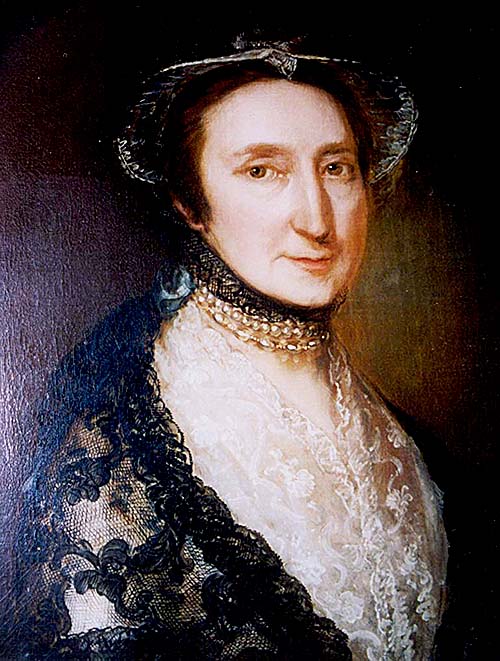
Elizabeth
Tugwell painted by Thomas Gainsborough

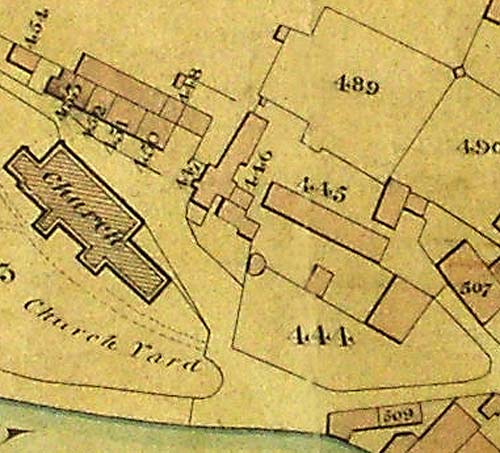
1837
Ashmead Map using different numbers to those of the 1841Tithe Map
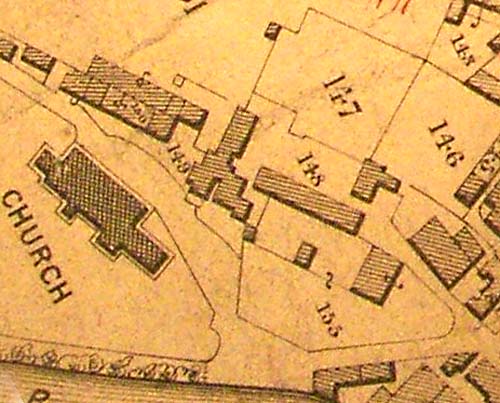
144 Garden, Ezekiel Edmonds (Cornelius Taylor)
145 Garden, and stable, Ezekiel Edmonds (Himself)
146 Garden, Ezekiel Edmonds (Himself)
147 Garden, Ezckiel Edmonds (Himself)
148 Abbey weaving shops, Ezekiel Edmonds (Himself)
149 House [school]. Trustees of Free School, Bradford (Themselves)
150 Five houses, and gardens, Rev. Henry Harvey; Vicarial Glebe (Himself)
151 Tenement, stable, and close adjoining/ pasture, Ezekiel Edmonds (Himself)
154 Parish Church, and churchyard,Rev. Henry Harvey; Vicarial (Himself)
155 House, lawn, and garden, Ezekiel Edmonds (Himself)
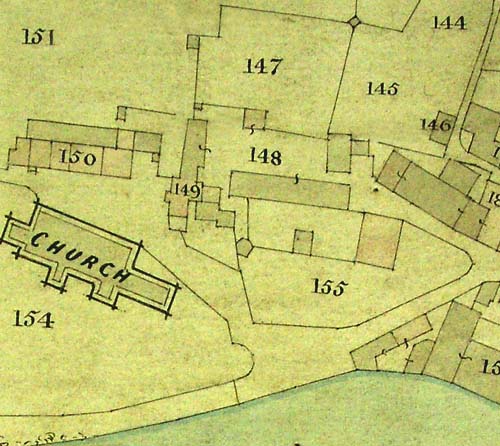
1864
Ashmead Map using Tithe Numbers
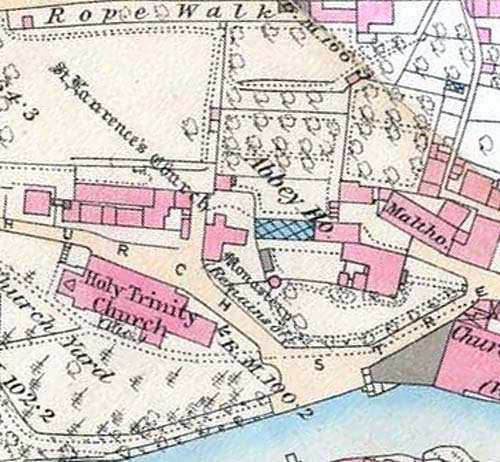
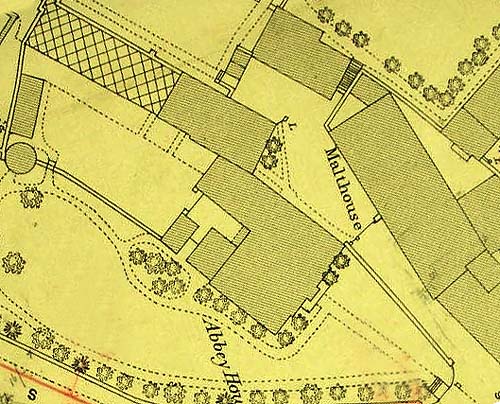
1886
Ordnance Survey Map
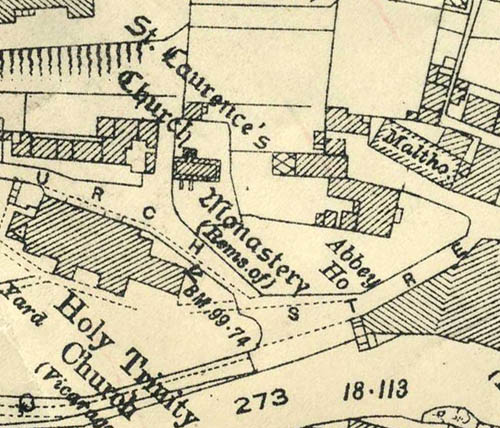
1924
Ordnance Survey Map
Leland visited Bradford (1538-40), and in his Itinerary, ii. 54, (printed in the Wilts Archseological Mag., i. 148,) speaks of a rich clothier named ''Horton,' who (his words seem to imply) died no very long time before, his wife being yet alive. He may allude to the same person as the founder of the Chantry. He dwelt, according to Leland, in a house built by himself " at the north est part by the Chirch." He also built " a goodly large chirch house ex lapide g_uadrato at the est end of the chireh yard without it." I can have no doubt that the present work-shops, in what is called the Abbey yard, belonging to Messrs. Edmonds, formed part of Horton's house, the situation exactly according with Leland's description, and having within unmistakable evidences of having been formerly a dwelling house. The ' Church House,' which is also said to have been built by Horton, is still standing ; it is situated in Church street, and is now the property of Mr. Butterworth. [The Church House is now the Free School, and is the property of the Trustees of the School (C.S.A.)] Both these buildings are of about the same date, and the similarity of their oak ceilings strikes you at once. The Church House, which, in a map of 1743, I have seen distinctly marked out as the building alluded to, was the place in which, before the days of rating, meetings were held for raising funds for church repairs, the poor, &c. The order of these meetings seems to have been " business first, pleasure afterwards," for no sooner had they attended to the wants of others than they had a little care for themselves, and indulging first of all in a little good cheer, then betook themselves to various kinds of festivities. The memory of one of their amusements is still preserved in the name-(happily now it is no more than a name)-of the Bull Pit, where they used to witness the then popular sport of bull-baiting.